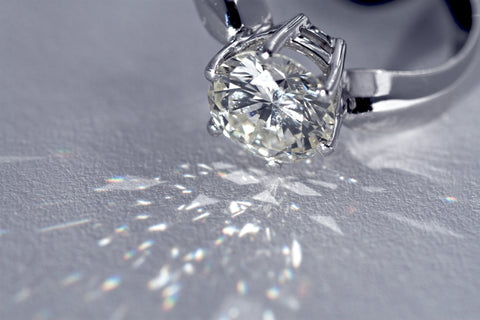The 4 C's of Diamonds
Cut • Color • Clarity • CaratsCUT
Cut is not to be confused with shape. Cut is the only human contribution to the diamond's beauty. However, it is one of the most important. In the jewelry industry, the term cut is primarily used to describe the proportions and finish of a diamond. Diamonds can be cut into almost any shape. Each diamond is cut using an exact mathematical formula that unleashes its brilliance and fire. These measurements and percentages are different for each diamond, and are all taken into account in the evaluation of a diamond’s cut. The mathematical formula also takes into account the depth of the cut. If a diamond is cut too shallow or too deep it will lose some of its fire. A well-cut diamond will reflect the light and refract it back out to your eye.

As you can see, the diamond with the correct proportions does a more effective job of refracting light out the top of the stone to your eye. The less-than-ideal cut diamonds allow some light to become lost out the bottom.
Cut also refers to the number of facets that the diamond has. Although the industry recognizes 57 facets on a round cut as the ideal diamond, there are many other specialty cuts available.
Cut also refers to the number of facets that the diamond has. Although the industry recognizes 57 facets on a round cut as the ideal diamond, there are many other specialty cuts available.
COLOR
While diamonds come in every color of the spectrum, the most valuable diamond color is colorless. These truly colorless diamonds are extremely rare. Diamonds are graded on a color scale established by the Gemological Institute of America (GIA).

Diamonds range from D (colorless) to Z (light yellow). The further down in the alphabet the diamond is, the more yellow it appears. Color can best be determined by looking at a loose diamond on a pure white surface, and by noting any contrast.
Fancy diamonds are what jewelers call colored diamonds. Pink, blue and canary yellow are the most popular colors of fancy diamonds. These colors can be natural or enhanced.
CLARITY
Nature produces few things that are perfect. The clarity grade is the degree to which the diamond is free of inclusions and blemishes. Internal imperfections and external irregularities affect the clarity of the diamond by interfering with the passage of light throughout the stone. Imperfections such as spots, lines, or bubbles are known as inclusions. The diamond is more valuable when it has fewer inclusions. According to the Gemological Institute of America's quality analysis system, clarity is graded on a scale ranging from flawless (FL or IF) to imperfect (I). The system is based on the visibility of inclusions at a magnification of 10x magnification.

A diamond's inclusions are like a fingerprint, making each diamond one-of-a-kind. Some jewelry stores drill out these natural inclusions and sell their treated diamonds for more.
CARAT WEIGHT
Carats and points determine the score.
Some people believe that carat refers to the size of a diamond when in actuality carat is the term used to measure a diamond's weight.
A diamond’s weight is measured in what is known as a ‘carat’, which is a small unit of measurement equal to 200 milligrams and there are 142 carats to an ounce. Carat (ct.) is not a measure of a diamond’s size, since cutting a diamond to different proportions can affect its weight.
A diamond’s weight is measured in what is known as a ‘carat’, which is a small unit of measurement equal to 200 milligrams and there are 142 carats to an ounce. Carat (ct.) is not a measure of a diamond’s size, since cutting a diamond to different proportions can affect its weight.

A carat is broken down into 100 points, just like a dollar is broken down into 100 pennies. So a 1-carat diamond has 100 points, a ¾ ct. has 75 points, etc. Points in a fraction of one carat are measured within ranges, so that a ¾ carat diamond may have between .69 and .82 points and still be considered a ¾ ct.
The larger a diamond is the rarer it is. Diamonds are bought and sold on per carat pricing. As diamonds get larger, the price per carat increases due to the rarity factor, so a diamond that weighs 2 ct. will be worth more than twice as much as a 1ct. diamond.


